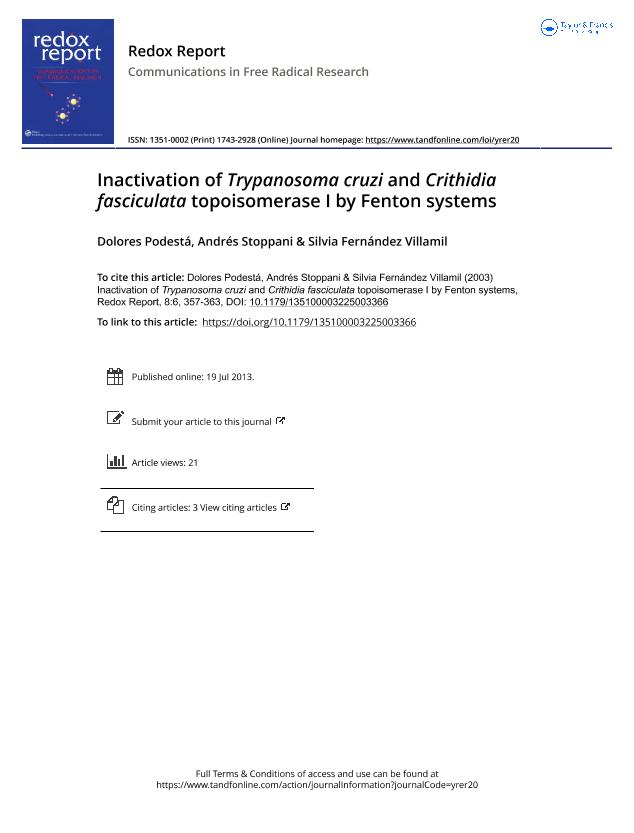Mostrar el registro sencillo del ítem
dc.contributor.author
Podestá, Dolores
dc.contributor.author
Stoppani, Andrés
dc.contributor.author
Fernandez Villamil, Silvia Hebe

dc.date.available
2019-07-19T18:28:50Z
dc.date.issued
2003-04
dc.identifier.citation
Podestá, Dolores; Stoppani, Andrés; Fernandez Villamil, Silvia Hebe; Inactivation of Trypanosoma cruzi and Crithidia fasciculata topoisomerase I by Fenton systems; Maney Publishing; Redox Report; 8; 6; 4-2003; 357-363
dc.identifier.issn
1351-0002
dc.identifier.uri
http://hdl.handle.net/11336/79915
dc.description.abstract
Fenton systems (H2O2/Fe(II) or H2O2/Cu(II)) inhibited Trypanosoma cruzi and Crithidia fasciculata topoisomerase I activity. About 61-71% inactivation was produced by 25 μM Fe(II) or Cu(II) with 3.0 mM H2O2. Thiol compounds and free radical scavengers prevented Fenton system effects, depending on the topoisomerase assayed. With the T. cruzi enzyme, reduced glutathione (GSH), dithiothreitol (DTT), cysteine and N-acetyl-L-cysteine (NAC) entirely prevented the effect of the H2O2/Fe(II) system; mannitol protected 37%, whereas histidine and ethanol were ineffective. With C. fasciculata topoisomerase, GSH, DTT and NAC protected 100%, cysteine, histidine and mannitol protected 28%, 34% and 48%, respectively, whereas ethanol was ineffective. With the H2O2/Cu(II) system and T. cruzi topoisomerase, DTT and histidine protected 100% and 60%, respectively, but the other assayed protectors were less effective. Similar results were obtained with the C. fasciculata enzyme. Topoisomerase inactivation by the H2O2/Fe(II) or H2O2/Cu(II) systems proved to be irreversible since it was not reversed by the more effective enzyme protectors. It is suggested that topoisomerases could act either as targets of 'reactive oxygen species' (ROS) generated by Fenton systems or bind the corresponding metal ions, whose redox cycling would generate reactive oxygen species in situ.
dc.format
application/pdf
dc.language.iso
eng
dc.publisher
Maney Publishing

dc.rights
info:eu-repo/semantics/openAccess
dc.rights.uri
https://creativecommons.org/licenses/by-nc-sa/2.5/ar/
dc.subject
Trypanosomatids
dc.subject
Ros
dc.subject.classification
Biología Celular, Microbiología

dc.subject.classification
Ciencias Biológicas

dc.subject.classification
CIENCIAS NATURALES Y EXACTAS

dc.title
Inactivation of Trypanosoma cruzi and Crithidia fasciculata topoisomerase I by Fenton systems
dc.type
info:eu-repo/semantics/article
dc.type
info:ar-repo/semantics/artículo
dc.type
info:eu-repo/semantics/publishedVersion
dc.date.updated
2019-07-16T14:12:34Z
dc.journal.volume
8
dc.journal.number
6
dc.journal.pagination
357-363
dc.journal.pais
Reino Unido

dc.journal.ciudad
London
dc.description.fil
Fil: Podestá, Dolores. Universidad de Buenos Aires. Facultad de Medicina; Argentina
dc.description.fil
Fil: Stoppani, Andrés. Universidad de Buenos Aires. Facultad de Medicina; Argentina
dc.description.fil
Fil: Fernandez Villamil, Silvia Hebe. Consejo Nacional de Investigaciones Científicas y Técnicas. Instituto de Investigaciones en Ingeniería Genética y Biología Molecular "Dr. Héctor N. Torres"; Argentina. Universidad de Buenos Aires. Facultad de Medicina; Argentina
dc.journal.title
Redox Report

dc.relation.alternativeid
info:eu-repo/semantics/altIdentifier/url/https://www.tandfonline.com/doi/abs/10.1179/135100003225003366
dc.relation.alternativeid
info:eu-repo/semantics/altIdentifier/doi/https://doi.org/10.1179/135100003225003366
Archivos asociados
